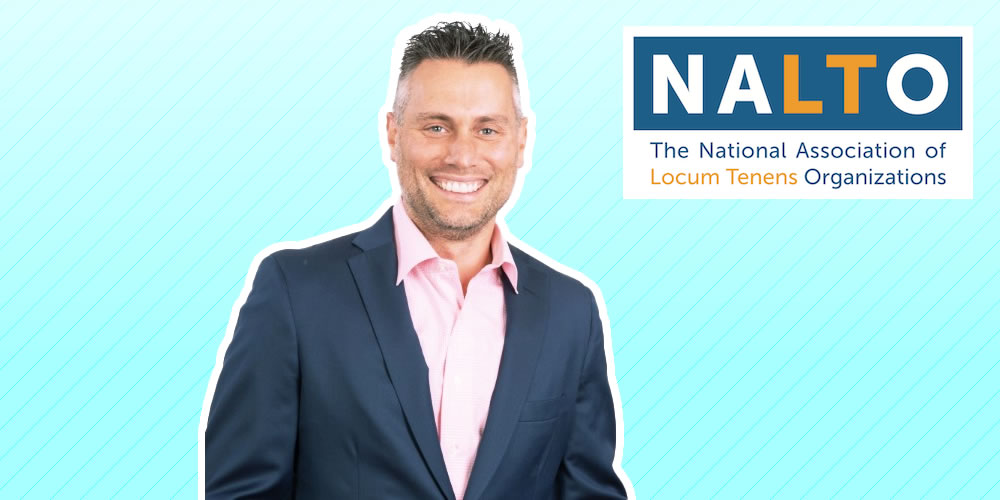Following one of the most challenging years on record, especially for the healthcare industry, the National Association of Locum Tenens Organizations (NALTO) has a new president: Matt Young, chief operating officer for All Star Healthcare Solutions.
Voted into office by the NALTO board a year early following Matt Erickson’s departure from the industry in mid-April, Young sees the proverbial glass as half-full, especially when it comes to the locum tenens industry.
Young began his healthcare staffing career as a consultant in Weatherby Healthcare’s anesthesia division in early 2004. After joining locum tenens staffing “start-up” Onyx MD roughly 19 months later (as director of operations), Young rose to executive vice president and managing partner while helping to build the organization into one of the country’s fastest-growing within five years.
Young joined All Star Healthcare Solutions, then a permanent-placement firm for physicians and advanced practice clinicians, in February 2010 as executive vice president and director of operations. While co-founding and developing the company’s locum tenens staffing division, he rose to chief operating officer and managing partner within less than a year. Having overseen functions including business development; CRM development; IT management; regulatory compliance; and the sales team management, Young now approaches 12 years with All Star Healthcare Solutions.
COVID-19’s Effects on the Industry
When asked whether the global pandemic has changed the industry in any lasting way, Young observes, “Facilities view us more as partners. The providers who work with us are no longer viewed as substandard. The business is no longer transactional — it’s much more strategic.”
Young believes the locum tenens industry is “recession-resistant but not pandemic-proof. Nevertheless, we have the ability to help the country in a time of great need.” He says the main healthcare-industry indicator shows “available days” for locum tenens clinicians back to 90- to 95-percent of normal.
“Because of a continuing staffing shortage of 90,000 to 100,000 clinicians by 2025, we’re strongly positioned to rebound well — and to help the country rebound — from crises like the COVID-19 pandemic,” Young notes. “This continues shifting the ‘balance of power,’ if you will, toward providers, which, he thinks, will increase the need to form strategic partnerships with them” to the extent possible.
When asked how and to what extent the pandemic changed demand for clinicians across the country, Young suggests several factors currently at play:
1. Young: A lot of physicians retired early during the pandemic.
In fact: Aaccording to Becker’s Hospital Review on April 30, “A November analysis from Pew Research Center found 1.2 million more baby boomers, those born between 1946 and 1964, reported being retired compared to previous years. The number of people expecting to work past age 67 dropped to a record low (39.2 percent) in March, according to a New York Federal Reserve survey.
“The trend could be especially staunch in healthcare, given that nearly a third of physicians are over 60, according to the nonprofit Physicians Foundation.”
2. Young: Work/life balance has become increasingly important, especially for clinicians.
In fact: From that same Becker’s Hospital Review post, “Financial advisers report a fresh ‘life-is-short’ sentiment among clients considering hanging up their hats early…”
And from Becker’s Hospital Review on April 21, “YOLO. It stands for ‘you only live once,’ and it’s fueling a new brand of employee exit.
“Kevin Roose, a technology columnist for The New York Times, writes that the anxiety experienced throughout the pandemic’s first year is motivating a growing number of people with financial cushions and in-demand skills to act on a fresh kind of ‘professional fearlessness…Many YOLO-fueled resignations ‘seem related to a deeper, generational disillusionment…’ writes Mr. Roose.”
3. Young: Trends among patient popluations most seriously affected by COVID-19 suggest there should be more emphasis on preventive care.
In fact: A March 23 post from the Mayo Clinic News Network emphasizes the importance of preventive screenings, the number of which declined over the past year as COVID-19 increased people’s hesitancy to seek in-person healthcare.
The most common preventive screenings recommended by the U.S. Preventive Services Task Force are prostate cancer and abdominal aortic aneurysm screenings for older men, and Pap smears and mammograms for women.
“If we pick it up too late, then we don’t have as good of a leg up on the situation,” Mayo Clinic preventive medicine physician Cindy Kermott, MD, said.
4. Young: The pandemic changed everything for critical care — ICU departments will be beefing up and planning better for the future.
In fact: Locumpedia published a June 30, 2020, issue of Locums Digest highlighting some of the positive changes put into place in response to the COVID-19 crisis.
In our lead story about the need to continue routine care during crises, we suggested “strategically employing locum tenens providers while assessing patient volume and determining a longer-term staffing strategy could buy time and save costs in the end.”
In the same issue, “3 Keys to Healthcare Staffing in NYC During COVID-19” highlighted a June 11, 2020, Health Affairs abstract indicating, “New York Health + Hospitals (NYC H+H) leaders attributed the system’s successful COVID-19 healthcare staffing strategy to communication, flexibility and technology…”
5. Young: Healthcare facilities will be better staffed with hospitalists to provide in-patient care.
In fact: Locum tenens hospitalists could offer an efficient solution.
A February 12 Medscape Medical News article highlighted research indicating, “Care by locum tenens hospitalists, often thought to be an expensive solution to staffing shortages, may have advantages in patient outcomes and hospital costs, a new observational study suggests.
“ ‘The results…may help debunk common perceptions that care either by teaching services or by locum tenens is inferior,’ lead author Moaath K. Mustafa Ali, MD, MPH, told Medscape Medical News…
6. Young: The primary care movement toward concierge medical practice* (AKA “retainer medical practice”) will gain momentum, as it allows physicians to better monitor and manage patient care.
In fact: “In 2020, concierge practice doctors saw a 21% increase in new patient volumes nationally, according to Kona Medical Consulting in a March 11, WellcomeMD news release posted on Yahoo! Finance. “In Naples, Fla., the waitlists have continued to grow. Virginia-based WellcomeMD has opened a new office in this southern Florida community to meet the growing desire for a personal approach to health care…”
On the Evolution of the Locum Tenens Industry
Considering Young’s 17+ years’ experience, we asked him about the locum tenens industry’s evolution over the past couple of decades and any emerging trends. Of course, he cites the evaporating, if not almost nonexistent, stigma associated with working locum tenens today. Further, he observes:
- “More providers are working locum tenens full-time.
- “More providers are willing to serve areas of great need.
- “Regardless of MSP (managed service provider) technology, agencies are still needed.
- “Clients now expect a higher level of service than they did in the past. Service has become the differentiator. (Thus, All Star’s “red-carpet service” for associates, providers, patients, clients and community.)
- “Demand will continue to drive the industry. Partially because of so many clinician departures, a massive deficit in the next 5 to 10 years is likely — especially considering the long lead-time required to produce new physicians and advanced practice clinicians.
- Also, patient engagement is already on the rise, and that trend will only grow.” Noting All Star has made patients part of its mission statement, Young said it’s gratifying to see the thank-you letters and photos the company receives for the providers sent and the lives affected by their care.
COVID-19’s Effects on NALTO
For starters, it’s interesting to note that while many organizations have had to adjust to virtual meetings in lieu of face-to-face gatherings, the NALTO board actually got a bit of an upgrade. While the board traditionally has met via conference call, it now meets via Zoom video conferencing. “I think adding the video component creates more engagement and accountability,” Young says.
Also, while NALTO got high marks on its virtual annual conference this year, he notes the group will return to live meetings in September with NALTO’s “Fall Fly-in” in New Orleans: Regarding NALTO’s increasing government relations involvement, Young assures this will continue to be a major focus for the association:
“I’m passionate about how crucial the locum tenens industry is to healthcare delivery, especially for facilities like those serving populations like our veterans and American Indians. We continue talking to US representatives and senators to convince them not to lump our providers in with other types of workers in the ‘gig’ economy. Changing clinicians’ employment status for tax purposes would significantly thin the provider ranks; we can’t let that happen.”
Speaking about NALTO’s other priorities, Young offers, “We understand that NALTO’s membership is mostly smaller companies, so we’re trying to create more value for those members in areas like lobbying, training and vendor discounts through our partner companies.”
He adds that the organization “will continue engaging with nonmember firms to bring them ‘into the fold.’ Ultimately, we want to make the industry better — not just for locum tenens companies, but for healthcare providers and patients, as well.”
Asked about the industry outlook for the remainder of 2021, Young — ever the optimist — suggests, “2021 probably will be a ‘catch-up year.’ But the future’s so bright you gotta wear shades!”
—
*Also known as “retainer medical practice,” “concierge medical practice” describes a relationship between a patient and a primary care physician in which the patient pays an annual fee or retainer. This may or may not be in addition to other charges. In exchange for the retainer, doctors agree to provide enhanced care, including principally a commitment to limit patient loads to ensure adequate time and availability for each patient.








